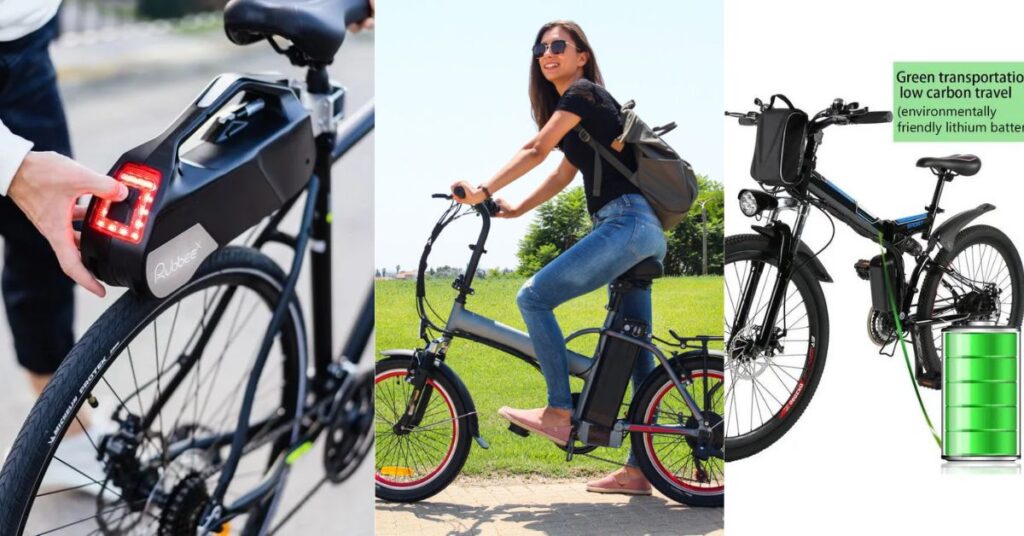Electric bikes have surged in popularity in recent years offering a convenient and eco-friendly mode of transportation for many riders. However one critical aspect that determines the performance and usability of an electric bike is the size of its battery. In this comprehensive guide we’ll research into the intricacies of battery sizing for electric bikes and help you make an informed decision when choosing the best battery size for your needs.
Understanding E-bike Battery & Capacity
Electric bike batteries serve as the powerhouse behind the smooth, effortless rides that e-bike enthusiasts cherish. In this section, we’ll investigate into the intricacies of e-bike batteries and their capacity, shedding light on the essential aspects that every rider should grasp.

E-bike batteries operate on a simple yet powerful principle: they convert stored electrical energy into kinetic energy, propelling the bike forward with ease. Understanding the key metrics of e-bike batteries is crucial for optimizing performance and longevity.
Voltage, measured in volts (V), determines the power output of the battery. Higher voltage batteries deliver more potent bursts of energy, resulting in faster acceleration and improved climbing ability. However it’s essential to strike a balance between voltage and capacity to ensure optimal performance without sacrificing range.
Capacity, quantified in ampere-hours (Ah), refers to the amount of energy a battery can store. Think of capacity as the fuel tank of your e-bike it determines how far you can travel on a single charge. Larger capacity batteries offer extended range, allowing riders to embark on longer journeys with confidence.
When selecting an e-bike battery considers your range requirements and riding habits. Commuters may opt for smaller capacity batteries that offer sufficient range for daily trips, while adventure seekers might prefer larger capacity batteries for extended touring.
Weight is another critical factor to consider. Larger capacity batteries tend to be heavier, affecting the overall weight and maneuverability of the bike. Strike a balance between capacity and weight to ensure a comfortable riding experience without compromising performance.
Cost is also a significant consideration. Higher capacity batteries typically come with a higher price tag, reflecting the increased energy storage and performance they offer. Assess your budget constraints and riding needs to find the optimal balance between cost and performance.
By understanding the nuances of e-bike batteries and their capacity, riders can make informed decisions when selecting the right battery for their needs. Whether commuting through city streets or exploring rugged trails choosing the right battery size ensures a seamless and enjoyable riding experience.
Recommended Post: Insurance For Rent Car In Duncanville Panggon
Battery Size and Its Impact on Range
- Battery size, determined by voltage and capacity, significantly impacts an electric bike’s performance and range.
- Higher voltage batteries deliver more power, while larger capacity batteries provide extended range.
- Riders should consider their range requirements, weight preferences, and budget constraints when selecting the optimal battery size.
- Larger battery sizes offer extended range, making them suitable for long-distance touring or adventurous rides.
- However, riders should be mindful of added weight and cost associated with larger batteries.
- Factors such as riding style, terrain, and weather conditions also influence an e-bike’s range and battery efficiency.
- By carefully considering these factors and selecting the right battery size, riders can enjoy seamless and efficient rides tailored to their needs.
- Choosing the optimal battery size ensures a balanced and enjoyable riding experience, whether commuting or embarking on adventures.
Assessing Your Riding Needs
When assessing your riding needs, it’s essential to first consider the typical distance and frequency of your rides. Understanding how often you ride and the distances you cover will help you accurately gauge your range requirements.
Take into account the terrain you’ll be traversing. Whether you’ll mainly ride on flat city streets, encounter hilly terrains, or tackle rugged trails, the terrain significantly impacts battery usage and, consequently, the required battery size.
Finally, evaluate your riding style and speed preferences. If you enjoy a leisurely cruise or prefer to zoom through traffic, ensure your chosen battery size can support your desired performance to enhance your riding experience.
Factors to Consider When Choosing the Best E-Bike Battery Size
When choosing your e-bike’s battery, factor in the power demands of your planned journeys. Similar to how the towering cliffs of Perth require robustness, specific rides necessitate added strength. Opting for a larger battery equips you with the vigor required to conquer inclines like a champion and navigate effortlessly through your routes.

1. Riding Style, Terrain, and Distance: Paving the Path to Perfect E-Bike Battery Capacity
Tailor your e-bike battery capacity to match your riding style, terrain, and typical riding distance. Assessing these factors ensures optimal performance and range.
Consider the demands of your journey to select the perfect battery size for a seamless riding experience. Matching capacity to your needs paves the way for enhanced enjoyment and efficiency.
2. The Battery Type: Powering Up with Lithium-Ion Technology

Lithium-ion technology reigns supreme in e-bike batteries, offering lightweight, high-energy density solutions. Opting for lithium-ion ensures efficient power delivery and longer cycle life, enhancing your riding experience.
Embrace this cutting-edge technology for reliable performance and extended range on your electric bike adventures. Power up with lithium-ion and enjoy a ride that’s both powerful and enduring.
3. Charging Method and E-Bike Battery Performance: A Direct Connection
The charging method directly impacts e-bike battery performance, influencing longevity and efficiency. Optimal charging practices, such as avoiding overcharging and maintaining proper voltage levels, enhance battery lifespan.
Understanding this connection ensures sustained performance and reliability for your electric bike. Implementing appropriate charging methods safeguards battery health, allowing for consistent and long-lasting performance on every ride.
4. Ambient Temperature: Navigating the Climate for Optimal Battery Capacity
Ambient temperature significantly influences e-bike battery capacity, affecting performance and range. Extreme temperatures, both hot and cold, can diminish battery efficiency and lifespan.
Optimal operating temperatures ensure consistent and reliable battery performance. Understanding how climate impacts battery capacity allows riders to plan accordingly for varying weather conditions.
5. The Balance of Electric Bike Battery Capacity, Price, and Weight: Striking the Perfect Chord
Balancing electric bike battery capacity, price, and weight is essential for finding the perfect harmony. Consider the trade-offs between larger capacity, higher price, and increased weight. Striking the right balance ensures optimal performance without breaking the bank or compromising maneuverability.
Evaluate your priorities to find the ideal combination that meets your needs and preferences. By achieving this balance, riders can enjoy a seamless and satisfying riding experience.
Top of Form
6. Battery Brand and Supplier: Trustworthy Partners for a Memorable Ride

Choosing the right e-bike battery brand and supplier is key to a smooth and enjoyable ride on your electric bike. Here’s what you should look for:
Reputable Brands:
Major Cell Manufacturers: Look for batteries that use cells from established names like Samsung, Panasonic, and LG. These manufacturers prioritize quality and safety.
Established E-bike Battery Brands: Companies like Tritek and Chilwee specialize in e-bike batteries and offer reliable products with good warranties.
Trustworthy Suppliers:
Safety Certifications: Ensure the batteries you consider have passed safety certifications like UN38.3 (for transport) and UL 2054 (for electrical safety).
Customer Reviews: Read reviews from other e-bike riders about the supplier’s customer service, product quality, and warranty support.
Compatibility: Double-check that the battery you choose is compatible with your specific e-bike model in terms of voltage (e.g., 36V, 48V) and capacity (e.g., 10Ah, 15Ah).
Read This Blog: Rena Monrovia When You Transport Something by Car .
Battery Longevity and Maintenance
- Battery longevity is crucial for maximizing the lifespan and performance of your e-bike.
- Proper maintenance practices, such as regular charging and storage, are essential for preserving battery health.
- Avoiding extreme temperatures and overcharging helps extend battery lifespan and maintain optimal performance.
- Implementing routine inspections and maintenance checks ensures the longevity and reliability of your e-bike battery.
- Following manufacturer guidelines and recommendations for battery care and maintenance is key to maximizing longevity and performance.
Frequently Asked Questions
What is the most common e-bike battery?
The most common e-bike battery is the lithium-ion battery due to its high energy density and reliability.
Is 500Wh battery enough for an ebike?
A 500Wh battery can be sufficient for many riders, providing a range of around 20-50 miles depending on factors such as terrain and riding style.
How long does a standard e-bike battery last?
The lifespan of a standard e-bike battery varies depending on usage and maintenance, but they typically last between 2 to 5 years or around 500 to 1000 charge cycles.
What is the most popular battery type?
Lithium-ion batteries are the most popular type for e-bikes due to their high energy density, lightweight design, and long lifespan.
Which brand batteries last the longest?
There isn’t one specific brand that universally lasts the longest, as longevity depends on factors such as usage and maintenance. However, reputable brands known for quality and durability include Bosch, Panasonic, and Shimano.
Which batteries are better alkaline or lithium?
Lithium batteries are generally better for high-drain devices like e-bikes due to their higher energy density, longer lifespan, and lighter weight compared to alkaline batteries.
Are Energizer lithium batteries worth it?
Energizer lithium batteries are known for their reliability and long-lasting performance, making them a worthwhile investment for devices like e-bikes where durability and longevity are important.
What happens if I use alkaline batteries instead of lithium?
Using alkaline batteries instead of lithium in high-drain devices like e-bikes may result in shorter runtime, reduced performance, and potentially even damage to the device due to the lower energy density and capacity of alkaline batteries.
Final Thoughts
To determining the best battery size for your electric bike requires careful consideration of various factors such as riding style, terrain, and range requirements. By assessing these factors and selecting the optimal battery capacity, riders can ensure a seamless and enjoyable riding experience.
Whether commuting through city streets or embarking on off-road adventures, choosing the right battery size is crucial for maximizing performance and range.
Remember to prioritize reliability and quality when selecting a battery, and always adhere to proper charging and maintenance practices to prolong its lifespan. With the right battery size and care, your electric bike journey will be powered by efficiency, reliability, and endless possibilities.

